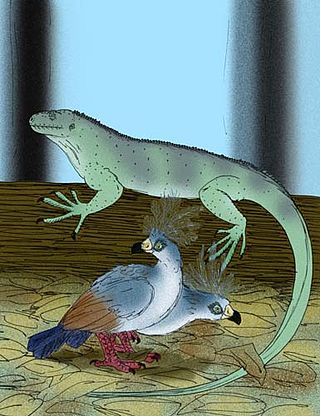
Fiji is a group of volcanic islands in the South Pacific, lying about 4,450 kilometres (2,765 mi) southwest of Honolulu and 1,770 km (1,100 mi) north of New Zealand. Of the 332 islands and 522 smaller islets making up the archipelago, about 106 are permanently inhabited. The total land size is 18,272 km2 (7,055 sq mi). It has the 26th largest Exclusive Economic Zone of 1,282,978 km2 (495,361 sq mi).

Viti Levu is the largest island in the Republic of Fiji. It is the site of the nation's capital, Suva, and home to a large majority of Fiji's population.

Platymantis is a genus of frogs in the family Ceratobatrachidae. They are commonly known as wrinkled ground frogs, ground frogs, and forest frogs.

The Viti Levu giant pigeon or Fiji giant ground pigeon is an extinct flightless pigeon of Viti Levu, the largest island in Fiji. It was only slightly smaller than the dodo and Rodrigues solitaire and is the first giant flightless pigeon to be discovered on a Pacific island.

The pink-billed parrotfinch is a species of estrildid finch found on the island of Viti Levu, Fiji. Commonly found at undisturbed mature forest in the centre and east of Viti Levu, e.g. Joske's Thumb near Suva. This species is found at mid-height along tree-trunks and branches, usually alone or in pairs but also joining mixed-species flocks, feeding primarily on insects, but also on flower buds and fruits.

Platymantis corrugatus is a species of frog in the family Ceratobatrachidae. It is endemic to the Philippines, where it is found throughout the archipelago except Palawan. Its natural habitats are tropical moist lowland forest and subtropical or tropical moist montane forest. It is threatened by habitat loss. Platymantis corrugatus is one of the most common Platymantis species in the Philippines.
Cornufer gilliardi, commonly known as Gilliard's wrinkled ground frog, is a species of frog in the family Ceratobatrachidae. It is endemic to the Whiteman Ranges of New Britain, Bismarck Archipelago. The specific name gilliardi honors Ernest Thomas Gilliard, an American ornithologist who, together with Margaret Gilliard, collected the holotype.

Platymantis guentheri is a species of frog in the family Ceratobatrachidae. It is endemic to the Philippines, where it occurs in the rainforests of Leyte, Biliran, Maripipi, Bohol, Panglao, Dinagat, and Mindanao islands. Its natural habitats are subtropical or tropical moist lowland forest, subtropical or tropical moist montane forest, plantations, rural gardens, and heavily degraded former forest. It has been observed as high as 700 meters above sea level.

Platymantis insulatus is a species of frog in the family Ceratobatrachidae. It is endemic to the Gigante Islands just northeast of Panay, the Philippines. This frog is variously known as the Gigantes wrinkled ground frog, island forest frog, South Gigante Island frog, Gigantes forest frog, and Gigantes limestone frog. Originally described from South Gigante, it is now known to occur on at least three other islands.
The smooth-skinned forest frog is a species of frog in the family Ceratobatrachidae. It is endemic to Romblon, Philippines. It occurs on Sibuyan Island, and may also occur on other nearby islands.
The Negros forest frog is a species of frog in the family Ceratobatrachidae. It is endemic to Panay and Negros, Philippines. It has been observed between 200 and 1800 meters above sea level.
Platymantis spelaeus, also known as the Negros cave frog or cave wrinkled ground frog, is a species of frog in the family Ceratobatrachidae. It is endemic to the Philippines, where it is only found in the forested limestone areas of southern Negros. It is one of the two cave-dwelling Platymantis species, the other one being Platymantis insulatus.

Cornufer vitianus, commonly known as Fiji ground frog or Viti wrinkled ground frog, is a species of frog in the family Ceratobatrachidae. It is endemic to Fiji.

Platymantis vitiensis is a species of frog in the family Ceratobatrachidae. It is one of two endemic frogs in Fiji, the other being the closely related Platymantis vitianus.
Trevor Henry Worthy is an Australia-based paleozoologist from New Zealand, known for his research on moa and other extinct vertebrates.

The Ceratobatrachidae are a family of frogs found in the Malay Peninsula, Borneo, the Philippines, Palau, Fiji, New Guinea, and the Admiralty, Bismarck, and Solomon Islands.
Vitirallus watlingi, the Fiji rail or Viti Levu rail, was a prehistoric flightless bird from Fiji, and is the only species in the genus Vitirallus. Vitirallus watlingi is thought to have been about the same size as the bar-winged rail but with a very elongated and slender bill.

Platymantis biak, also known as the Luzon limestone forest frog, is a species of frog in the family Ceratobatrachidae. It is endemic to the island of Luzon, the Philippines, where it is known from the Biak-na-Bato National Park, its type locality, and from the immediate vicinity of the park. The specific name biak is Tagalog meaning "crevice" or "crack" and refers to the preferred limestone karst habitat at the type locality.
Platymantis quezoni is a species of frog in the family Ceratobatrachidae. It is endemic to the Philippines. Its type locality is in the Quezon Protected Landscape, where it is found in limestone karst habitats. It may also be found in limestone karst habitats in Bondoc Peninsula.

The Fiji tropical moist forests is a tropical moist forest ecoregion in Fiji and Wallis and Futuna. It covers the windward sides of Viti Levu and Vanua Levu, Fiji's largest islands, as well as the smaller Fijian islands and the three islands that make up Wallis and Futuna, an overseas territory of France.











